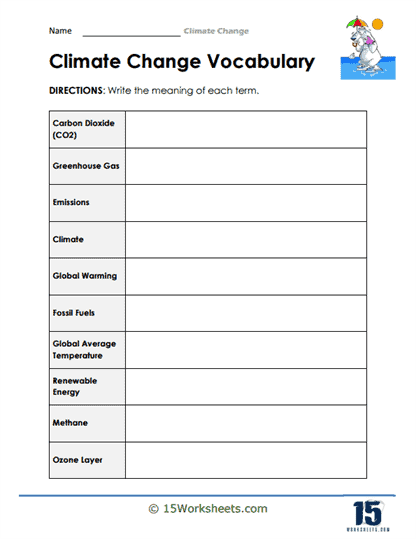Climate Change Vocabulary

Worksheet Description
Students will write the meaning of each term. The collection of terms include: Carbon Dioxide (CO2), Greenhouse Gas, Emissions, Climate, Global Warming, Fossil Fuels, Global Average Temperature, Renewable Energy, Methane, and Ozone Layer.
The worksheet is aimed at gauging a student’s understanding of pivotal terms related to climate change. Decorated with a graphic of a character carrying an ice block, it symbolically underscores the dire consequences of global warming. By providing a list of ten crucial terms, it invites students to articulate their definitions, ensuring they can comprehend and express fundamental concepts related to the topic. Each term, from “Carbon Dioxide” to “Ozone Layer,” forms the building blocks for a more in-depth study of climate science and environmental discussions.
To effectively complete this worksheet, students should first read through the list of terms to identify those they are familiar with. Afterward, they should pen down concise definitions for each term based on their existing knowledge. In cases where they’re unsure or seek confirmation, consulting textbooks, class notes, or reputable online sources can provide clarity. Once all definitions are drafted, it’s beneficial to review and cross-check them for accuracy, ensuring a solid grasp of each term’s significance in the context of climate change.
Through this worksheet, educators aspire to fortify students’ foundational knowledge of climate change lexicon. By asking students to write out definitions, it encourages them not only to recall information but also to articulate it in their own words. Such an exercise reinforces comprehension and retention. Ultimately, the worksheet serves as both a testing and teaching tool, preparing students for more intricate discussions on climate science by ensuring they are conversant with its basic vocabulary.
